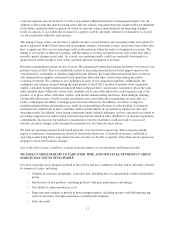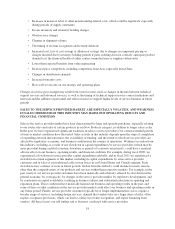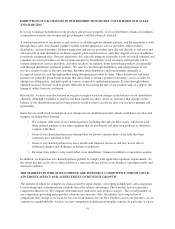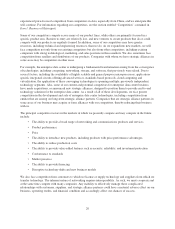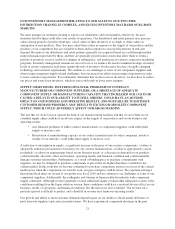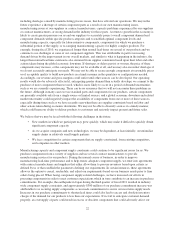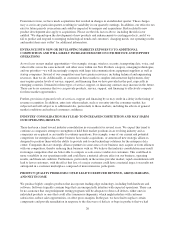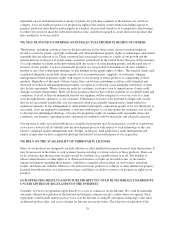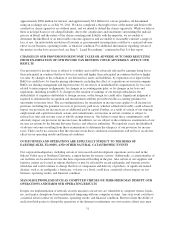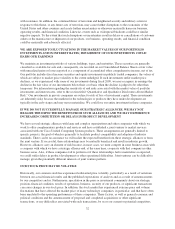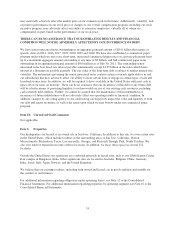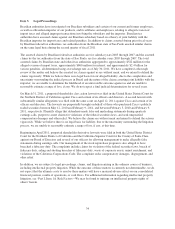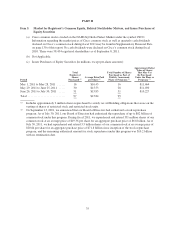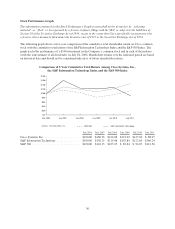Cisco 2011 Annual Report Download - page 35
Download and view the complete annual report
Please find page 35 of the 2011 Cisco annual report below. You can navigate through the pages in the report by either clicking on the pages listed below, or by using the keyword search tool below to find specific information within the annual report.shipped. Although the cost of such remediation has not been material in the past, there can be no assurance that
such a remediation, depending on the product involved, would not have a material impact. An inability to cure a
product defect could result in the failure of a product line, temporary or permanent withdrawal from a product or
market, damage to our reputation, inventory costs, or product reengineering expenses, any of which could have a
material impact on our revenue, margins, and net income.
DUE TO THE GLOBAL NATURE OF OUR OPERATIONS, POLITICAL OR ECONOMIC CHANGES
OR OTHER FACTORS IN A SPECIFIC COUNTRY OR REGION COULD HARM OUR OPERATING
RESULTS AND FINANCIAL CONDITION
We conduct significant sales and customer support operations in countries outside of the United States and also
depend on non-U.S. operations of our contract manufacturers, component suppliers and distribution partners.
Although sales in several of our emerging countries decreased during the recent global economic downturn,
several of our emerging countries generally have been relatively fast growing, and we have announced plans to
expand our commitments and expectations in certain of those countries. As such, our growth depends in part on
our increasing sales into emerging countries. Our future results could be materially adversely affected by a
variety of political, economic or other factors relating to our operations outside the United States, any or all of
which could have a material adverse effect on our operating results and financial condition, including, among
others, the following:
• The worldwide impact of the recent global economic downturn and related market uncertainty,
including the recent European economic and financial turmoil related to sovereign debt issues in
certain countries
• Foreign currency exchange rates
• Political or social unrest
• Economic instability or weakness or natural disasters in a specific country or region; environmental
and trade protection measures and other legal and regulatory requirements, some of which may affect
our ability to import our products, to export our products from, or sell our products in various countries
• Political considerations that affect service provider and government spending patterns
• Health or similar issues, such as a pandemic or epidemic
• Difficulties in staffing and managing international operations
• Adverse tax consequences, including imposition of withholding or other taxes on payments by
subsidiaries
WE ARE EXPOSED TO THE CREDIT RISK OF SOME OF OUR CUSTOMERS AND TO CREDIT
EXPOSURES IN WEAKENED MARKETS, WHICH COULD RESULT IN MATERIAL LOSSES
Most of our sales are on an open credit basis, with typical payment terms of 30 days in the United States and,
because of local customs or conditions, longer in some markets outside the United States. We monitor individual
customer payment capability in granting such open credit arrangements, seek to limit such open credit to
amounts we believe the customers can pay, and maintain reserves we believe are adequate to cover exposure for
doubtful accounts. Beyond our open credit arrangements, we have also experienced demands for customer
financing and facilitation of leasing arrangements. We expect demand for customer financing to continue, and
recently we have been experiencing an increase in this demand as the credit markets have been impacted by the
recent global economic downturn and related market uncertainty, including increased demand from customers in
certain emerging countries. We believe customer financing is a competitive factor in obtaining business,
particularly in serving customers involved in significant infrastructure projects. Our loan financing arrangements
may include not only financing the acquisition of our products and services but also providing additional funds
for other costs associated with network installation and integration of our products and services.
27


